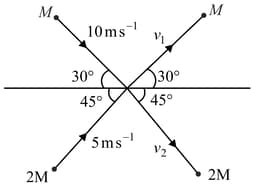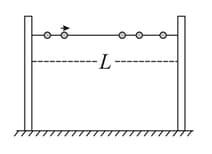Linear momentum is always conserved in an inelastic collision.
Important Questions on Laws of Motion
This question has and of the four choices given after the Statements, choose the one that best describes the two Statements.
A point particle of mass moving with speed collides with stationary point particle of mass . If the maximum energy loss possible is given as
then .
Maximum energy loss occurs when the particles get stuck together as a result of the collision.

Two particles of masses and are moving with speeds of and , as shown in the figure. They collide at the origin and after that they move along the indicated directions with speeds and , respectively. The values of and are, nearly

A large number of identical beads, each of mass and radius are strung on a thin smooth rigid horizontal rod of length and are at rest at random positions. The rod is mounted between two rigid supports (see figure). If one of the beads is now given a speed , the average force experienced by each support after a long time is (assume all collisions are elastic):


